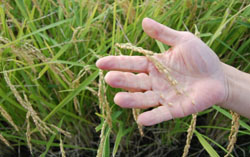- “New study warns that climate change could create agricultural winners and losers in east Africa.” Any other possibilities?
- “Researchers to perform sex change operation on papaya.” Bang goes a bunch of sexual diversity.
- Inherited wealth is good for farmers, better for herders, lousy for hunters.
- AGCommons is a CGIAR project to deliver information to farmers in Africa. Watch their new video, with added Andy Jarvis goodness.
Reviving an old rice for sake’s sake
“Use it or lose it” is a frequent refrain among those who want to conserve genetic resources. We strive to point out that nothing is ever useless, we just haven’t discovered the uses yet. Sometimes, though, the use is well-known. Brewers, especially the more traditional types, often swear by specific varieties of their raw material. Golden Promise, a famous malting barley, is spoken of fondly by bearded men in sandals clutching a pint of warm cloudy brew. So I shouldn’t be surprised that the same is true of Nihonshu (日本酒). A long article at The Japan Times explains how sake makers are increasingly trying to use traditional old rice varieties.
Wataribune was used in 1939 to develop the now-dominant Yamada Nishiki strain. It had been widely used in sake making for centuries but fell into near-extinction around 50 years ago. Though it was rumored to yield brews of great depth and complexity, it was notoriously difficult to grow. The plant’s tall stalks made it vulnerable to typhoons, while its long growing season exacerbated the risks. [Takaaki] Yamauchi proposed an initiative to revive the strain, but few farmers were willing to gamble on such an uncertain enterprise.
 The article goes on to describe how the master brewer eventually found 14 grams of Wataribune rice in the genebank at the National Agricultural Institute in Tsukuba, and parlayed that into a range of award-winning sakes. The photo, by article author Melinda Joe, shows how easily Wataribune rice grains fall from the ears of the stalk, making it a challenging rice strain to work with. There’s a lot more in the article, about rice varieties in sake and about ordinary Japanese people who are spearheading a movement towards more regional diversity in rice, including groups that reclaim and regenerate abandoned rice paddies.
The article goes on to describe how the master brewer eventually found 14 grams of Wataribune rice in the genebank at the National Agricultural Institute in Tsukuba, and parlayed that into a range of award-winning sakes. The photo, by article author Melinda Joe, shows how easily Wataribune rice grains fall from the ears of the stalk, making it a challenging rice strain to work with. There’s a lot more in the article, about rice varieties in sake and about ordinary Japanese people who are spearheading a movement towards more regional diversity in rice, including groups that reclaim and regenerate abandoned rice paddies.
Nibbles: Chocolate, Bloggers, Tokyo rice, Breeding, Nutrition
- Yesterday was National Chocolate Day. 1 Who knew? Not even the experts.
- Oxford 2009; report of the veg bloggers and breeders get-together.
- Ginza rice farm. What happened?
- How do we fund plant breeding? You will let us know, won’t you.
- More Food May Not Mean Less Hunger. Say it isn’t so.
Nibbles: Cryopreservation, Hunger, Rice
- US scientists put ash diversity in the deep freeze, for when they’ve solved the emerald ash borer menace.
- Millions fed: proven successes in agricultural development. A talk on 12 November in Washington DC. Jeremy sez: “To a man with a hammer, everything looks like a nail”.
- War! Huuh! What is it good for? Hybrid rice! Huh?
How to breed for the future
There’s an interesting discussion going on over at PBForum, an e-mail based forum for plant breeding and related fields managed by GIPB. It started out with a question from a Philippines breeder about how to get climate-ready rice varieties. I was particularly struck by the latest contribution, which basically said that, rather, we should be trying to…
…create climate-change-ready breeding programmes. That is, build in the flexibility to shift relatively quickly to a new climate related breeding objective, once it becomes established in what direction the climate will change and how it will affect crop yield.
What I would add is that such “climate-change-ready breeding programmes” would necessarily include ready access to as wide a range of raw materials as possible, including, crucially, properly evaluated collections of landraces and crop wild relatives conserved in, and readily accessible from, genebanks.